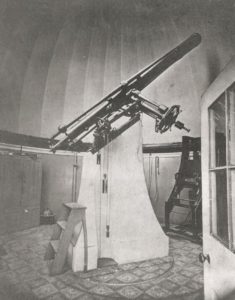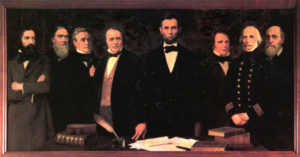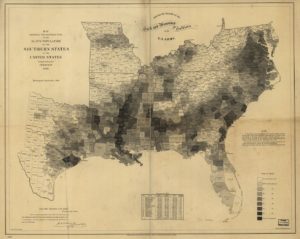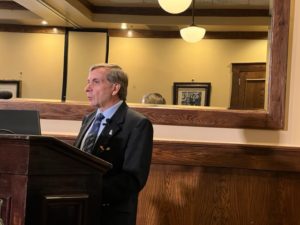 Abraham Lincoln was fascinated by science. One particular fascination was astronomy. Lincoln had attained some knowledge of basic astronomy in Indiana. By his seventeenth year, he had reached his adult six-foot-four-inch height, his 160 pounds glued to a taut muscular frame. Awkward in movement and dress, the uniqueness of his mind managed to impress at least some of the girls. One fifteen-year-old, Anna “Kate” Roby, found him more scientifically instructive than romantic as they sat on the banks of the Ohio River. After Roby noted in awe that the moon was going down, Lincoln lapsed into a rather clinical discourse on the nature of planetary movement: “That’s not so,” he said, “it don’t really go down; It seems so.” He went on to explain: “The Earth turns from west to East and the revolution of the Earth carries us under, as it were: we do the sinking as you call it. The moon as to us is comparatively still. The moons sinking is only an appearance.” Notwithstanding the rudimentary nature of this description, Roby concluded that “Abe knew the general laws of astronomy and the movements of the heavenly bodies,” which she attributed to him being better read than anyone else in the region—“a learned boy among us unlearned folks.” What he read to gain this knowledge is unknown, but Roby admitted that “No man could talk to me that night as he did unless he had known something of geography as well as astronomy.” At least one early researcher suggested Lincoln had access in Indiana to John O’Neill’s New and Easy System of Geography and Popular Astronomy. The book provides a basic introduction to geographical terms and how to read maps, plus an extensive history of each continent. This is followed by an extensive discussion of popular astronomy, the basics of the earth and moon’s movement, the causes of solar and lunar eclipses, and explanations of comets, meteors, and constellations. There are even chapters on the moon’s effect on tides, calculations of longitude, and weather prediction.
Abraham Lincoln was fascinated by science. One particular fascination was astronomy. Lincoln had attained some knowledge of basic astronomy in Indiana. By his seventeenth year, he had reached his adult six-foot-four-inch height, his 160 pounds glued to a taut muscular frame. Awkward in movement and dress, the uniqueness of his mind managed to impress at least some of the girls. One fifteen-year-old, Anna “Kate” Roby, found him more scientifically instructive than romantic as they sat on the banks of the Ohio River. After Roby noted in awe that the moon was going down, Lincoln lapsed into a rather clinical discourse on the nature of planetary movement: “That’s not so,” he said, “it don’t really go down; It seems so.” He went on to explain: “The Earth turns from west to East and the revolution of the Earth carries us under, as it were: we do the sinking as you call it. The moon as to us is comparatively still. The moons sinking is only an appearance.” Notwithstanding the rudimentary nature of this description, Roby concluded that “Abe knew the general laws of astronomy and the movements of the heavenly bodies,” which she attributed to him being better read than anyone else in the region—“a learned boy among us unlearned folks.” What he read to gain this knowledge is unknown, but Roby admitted that “No man could talk to me that night as he did unless he had known something of geography as well as astronomy.” At least one early researcher suggested Lincoln had access in Indiana to John O’Neill’s New and Easy System of Geography and Popular Astronomy. The book provides a basic introduction to geographical terms and how to read maps, plus an extensive history of each continent. This is followed by an extensive discussion of popular astronomy, the basics of the earth and moon’s movement, the causes of solar and lunar eclipses, and explanations of comets, meteors, and constellations. There are even chapters on the moon’s effect on tides, calculations of longitude, and weather prediction.
He expanded his understanding after moving to Illinois. Lincoln’s fellow circuit-riding colleague Leonard Swett said he observed Lincoln with “a geometry,” or “an astronomy,” that he would read between county courthouses. This could have been a copy of O’Neill but may also have been An Introduction to Astronomy by Denison Olmsted, released in 1839, which Lincoln definitely owned because a copy with Lincoln’s signature was offered for sale in 1926. In a much more comprehensive volume than O’Neill’s, Olmsted delves deeply into every aspect of astronomy, which may explain Lincoln’s growing understanding of astronomical phenomena over the elementary level expressed to Kate Roby. Lincoln never faltered in his growing interest in astronomy up to and including his time as president.
He may have also picked up some astronomy knowledge from his law partner William Herndon. Herndon’s auction list contains at least one astronomy text published while the two of them practiced law: Elias Loomis’s 1856 book The Recent Progress of Astronomy. On one occasion, he used his knowledge of astronomy to challenge a witness in a murder case – the famous “Almanac Trial” – who insisted the full moon lit up the scene as if the middle of the day. Lincoln successfully used the almanac to show the moon was actually very low in the sky by the time of the fatal incident. Having impugned the veracity of the witness, Lincoln was able to get an acquittal for his client, the son of an old friend.
In another example of his astronomical knowledge, Lincoln was gazing up at the stars while strolling along Lake Michigan in Chicago. While doing so he offered a spontaneous discourse on astronomical science to Adeline Judd, the wife of his close colleague Norman Judd. Adeline recalled that Lincoln began to speak of the mysteries, poetry, and beauty of the stars. He talked “of the discoveries since the invention of the telescope, which had thrown a flood of light and knowledge on what before was incomprehensible and mysterious; of the wonderful computations of scientists who had measured the miles of seemingly endless space which separated the planets in our solar system from our central sun, and our sun from other suns, which were now gemming the heavens above us with their resplendent beauty.” He even speculated on what “increased power of the lens” might help astronomers discover in the centuries to come. Lincoln was building off his previous sightings, having witnessed an exceptional display of the Leonid meteor showers in 1833 while living in New Salem. He may also have seen Miss Mitchell’s Comet, discovered in the night skies by Maria Mitchell in 1847. Mitchell would become the first female professor astronomy at newly founded Vassar College during the Civil War. The night before his Jonesboro debate with Stephen A. Douglas in 1858, Lincoln observed Donati’s Comet streak across the sky with its long, easily visible dust and gas tail. Horace White, a reporter for the Chicago Press & Tribune, was with him and reported that “Mr. Lincoln greatly admired this strange visitor, and he and I sat for an hour or more in front of the hotel looking at it.”
Lincoln continued his interest during the Civil War. War weary and worn out from the constant pressure, Lincoln occasionally made his way to the U.S. Naval Observatory to humor his interest in astronomy. In May 1863 he stopped by the observatory with Major General Daniel Butterfield. Three months later, Lincoln traveled to the observatory to look at the stars through the newly upgraded 9.6-inch telescope recently installed. He was met there by astronomer Asaph Hall, who helped Lincoln locate the bright star Arcturus. Lincoln visited the observatory on other occasions as well, often inviting others to join him. Longtime friend Joseph Gillespie told Herndon that Lincoln “invited me one day at Washington City to call upon him in the evening when he said we would go to the observatory and take a look at the Moon through the large telescope.” The night was cloudy and the excursion was called off. When not at the observatory, Lincoln peered through his own small telescope at the White House, searching alternatively for stars, sailing ships on the Potomac, or the red sandstone Castle of the Smithsonian Institution.
Later, Lincoln’s son Robert took interest in astronomy to a higher level, building an observatory at his retreat in Vermont called Hildene.
[Adapted from Lincoln: The Fire of Genius]
[Photo credit: Telescope at old Naval Observatory in Foggy Bottom, Office of Medical History]

Lincoln: The Fire of Genius: How Abraham Lincoln’s Commitment to Science and Technology Helped Modernize America was released on September 1, 2022.
The book is available for purchase at all bookseller outlets. Limited signed copies are available via this website. The book also listed on Goodreads, the database where I keep track of my reading. Click on the “Want to Read” button to put it on your reading list. Please leave a review on Goodreads and Amazon if you like the book.
You also follow my author page on Facebook.
David J. Kent is President of the Lincoln Group of DC and the author of Lincoln: The Fire of Genius: How Abraham Lincoln’s Commitment to Science and Technology Helped Modernize America and Lincoln: The Man Who Saved America.
His previous books include Tesla: The Wizard of Electricity and Edison: The Inventor of the Modern World and two specialty e-books: Nikola Tesla: Renewable Energy Ahead of Its Time and Abraham Lincoln and Nikola Tesla: Connected by Fate.



 Abraham Lincoln is well known as having interests in science, but he also had an interest in the arts. Join me at the Arts Club of Washington on October 26th to explore the arts and sciences of Abraham Lincoln. The event is open to the public.
Abraham Lincoln is well known as having interests in science, but he also had an interest in the arts. Join me at the Arts Club of Washington on October 26th to explore the arts and sciences of Abraham Lincoln. The event is open to the public. Lincoln took a scientific approach to military strategy. The Anaconda plan’s focus was on securing the coastlines and the Mississippi River. Recognizing New Orleans as the hub of the cotton trade and commerce, Lincoln saw it as the first port to be targeted for blockade. He also hoped to block southern ship traffic from Charleston, South Carolina to cut off Confederate attempts to woo Great Britain and France to their side. Helping him make this happen was Alexander Dallas Bache and the Coast Survey. The Coast Survey had been authorized by Thomas Jefferson, and Bache, who was Benjamin Franklin’s great-grandson, was quick to send nautical charts of the Chesapeake Bay to Lincoln. He also forwarded two terrestrial maps produced by the Survey that had far-reaching influence on Lincoln’s decisions on emancipation and military strategy.
Lincoln took a scientific approach to military strategy. The Anaconda plan’s focus was on securing the coastlines and the Mississippi River. Recognizing New Orleans as the hub of the cotton trade and commerce, Lincoln saw it as the first port to be targeted for blockade. He also hoped to block southern ship traffic from Charleston, South Carolina to cut off Confederate attempts to woo Great Britain and France to their side. Helping him make this happen was Alexander Dallas Bache and the Coast Survey. The Coast Survey had been authorized by Thomas Jefferson, and Bache, who was Benjamin Franklin’s great-grandson, was quick to send nautical charts of the Chesapeake Bay to Lincoln. He also forwarded two terrestrial maps produced by the Survey that had far-reaching influence on Lincoln’s decisions on emancipation and military strategy. I was interviewed for the summer 2022 issue of The Lincolnian, the newsletter of the Lincoln Group of DC. This is Part 3, the final part. Here is
I was interviewed for the summer 2022 issue of The Lincolnian, the newsletter of the Lincoln Group of DC. This is Part 3, the final part. Here is  In
In 






